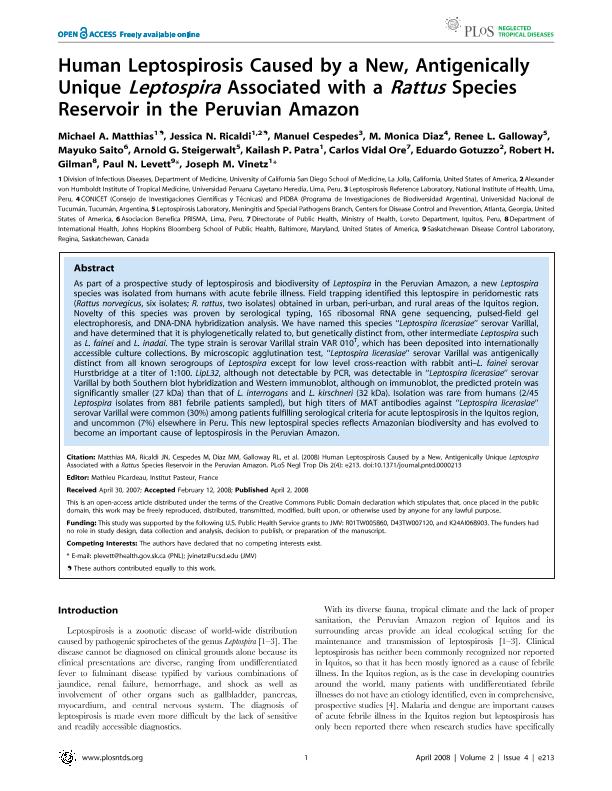Mostrar el registro sencillo del ítem
dc.contributor.author
Matthias, M.
dc.contributor.author
Ricaldi, Jessica. N.
dc.contributor.author
Cespedes, Manuel
dc.contributor.author
Díaz, María Mónica

dc.contributor.author
Galloway, R. L.
dc.contributor.author
Saito Mayuko
dc.contributor.author
Steigerwalt, Arnold G.
dc.contributor.author
Patra, Kallash P.
dc.contributor.author
Vidal Ore, Carlos
dc.contributor.author
Gotuzzo, Eduardo
dc.contributor.author
Gilman, Robert H.
dc.contributor.author
Levett, Paul N.
dc.contributor.author
Vinetz, Joshep M.
dc.date.available
2019-08-20T13:57:09Z
dc.date.issued
2008-12
dc.identifier.citation
Matthias, M.; Ricaldi, Jessica. N.; Cespedes, Manuel; Díaz, María Mónica; Galloway, R. L.; et al.; Human Leptospirosis caused by a new antigenically unique Leptospira associated with a Rattus species reservoir in the Peruvian Amazon; Mathieu Picardeau, Institut Pasteur, France; Plos Neglected Tropical Diseases; 2; e213; 12-2008; 1-12
dc.identifier.issn
1935-2735
dc.identifier.uri
http://hdl.handle.net/11336/81791
dc.description.abstract
As part of a prospective study of leptospirosis and biodiversity of Leptospira in the Peruvian Amazon, a new Leptospira species was isolated from humans with acute febrile illness. Field trapping identified this leptospire in peridomestic rats (Rattus norvegicus, six isolates; R. rattus, two isolates) obtained in urban, peri-urban, and rural areas of the Iquitos region. Novelty of this species was proven by serological typing, 16S ribosomal RNA gene sequencing, pulsed-field gel electrophoresis, and DNA-DNA hybridization analysis. We have named this species “Leptospira licerasiae” serovar Varillal, and have determined that it is phylogenetically related to, but genetically distinct from, other intermediate Leptospira such as L. fainei and L. inadai. The type strain is serovar Varillal strain VAR 010T, which has been deposited into internationally accessible culture collections. By microscopic agglutination test, “Leptospira licerasiae” serovar Varillal was antigenically distinct from all known serogroups of Leptospira except for low level cross-reaction with rabbit anti–L. fainei serovar Hurstbridge at a titer of 1∶100. LipL32, although not detectable by PCR, was detectable in “Leptospira licerasiae” serovar Varillal by both Southern blot hybridization and Western immunoblot, although on immunoblot, the predicted protein was significantly smaller (27 kDa) than that of L. interrogans and L. kirschneri (32 kDa). Isolation was rare from humans (2/45 Leptospira isolates from 881 febrile patients sampled), but high titers of MAT antibodies against “Leptospira licerasiae” serovar Varillal were common (30%) among patients fulfilling serological criteria for acute leptospirosis in the Iquitos region, and uncommon (7%) elsewhere in Peru. This new leptospiral species reflects Amazonian biodiversity and has evolved to become an important cause of leptospirosis in the Peruvian Amazon.
dc.format
application/pdf
dc.language.iso
eng
dc.publisher
Mathieu Picardeau, Institut Pasteur, France
dc.rights
info:eu-repo/semantics/openAccess
dc.rights.uri
https://creativecommons.org/licenses/by-nc-sa/2.5/ar/
dc.subject
Leptospira
dc.subject
Peruvian Amazon
dc.subject
New Species
dc.subject
Rattus
dc.subject.classification
Salud Ocupacional

dc.subject.classification
Ciencias de la Salud

dc.subject.classification
CIENCIAS MÉDICAS Y DE LA SALUD

dc.title
Human Leptospirosis caused by a new antigenically unique Leptospira associated with a Rattus species reservoir in the Peruvian Amazon
dc.type
info:eu-repo/semantics/article
dc.type
info:ar-repo/semantics/artículo
dc.type
info:eu-repo/semantics/publishedVersion
dc.date.updated
2019-08-14T18:54:20Z
dc.journal.volume
2
dc.journal.number
e213
dc.journal.pagination
1-12
dc.journal.pais
Estados Unidos
dc.journal.ciudad
San Francisco
dc.description.fil
Fil: Matthias, M.. University of California at San Diego; Estados Unidos
dc.description.fil
Fil: Ricaldi, Jessica. N.. University of California at San Diego; Estados Unidos
dc.description.fil
Fil: Cespedes, Manuel. National Institute of Health; Perú
dc.description.fil
Fil: Díaz, María Mónica. Universidad Nacional de Tucumán. Facultad de Ciencias Naturales e Instituto Miguel Lillo. Programa de Investigación de Biodiversidad Argentina; Argentina. Consejo Nacional de Investigaciones Científicas y Técnicas. Centro Científico Tecnológico Conicet - Tucumán; Argentina
dc.description.fil
Fil: Galloway, R. L.. Disease Control and Prevention, Atlanta; Estados Unidos
dc.description.fil
Fil: Saito Mayuko. Asociacion Benefica PRISMA; Perú
dc.description.fil
Fil: Steigerwalt, Arnold G.. Centers for Disease Control and Prevention, Atlanta; Estados Unidos
dc.description.fil
Fil: Patra, Kallash P.. University of California at San Diego; Estados Unidos
dc.description.fil
Fil: Vidal Ore, Carlos. Ministry of Health; Perú
dc.description.fil
Fil: Gotuzzo, Eduardo. Universidad Peruana Cayetano Heredia; Perú
dc.description.fil
Fil: Gilman, Robert H.. Johns Hopkins Bloomberg School of Public Health; Estados Unidos
dc.description.fil
Fil: Levett, Paul N.. Saskatchewan Disease Control Laboratory; Canadá
dc.description.fil
Fil: Vinetz, Joshep M.. University of California at San Diego; Estados Unidos
dc.journal.title
Plos Neglected Tropical Diseases
dc.relation.alternativeid
info:eu-repo/semantics/altIdentifier/url/https://journals.plos.org/plosntds/article?id=10.1371/journal.pntd.0000213
dc.relation.alternativeid
info:eu-repo/semantics/altIdentifier/doi/https://dx.doi.org/10.1371/journal.pntd.0000213
Archivos asociados
